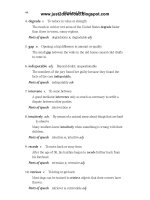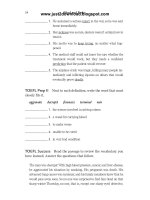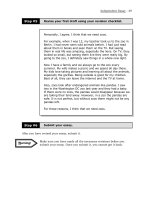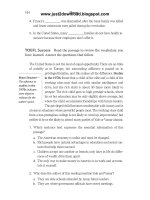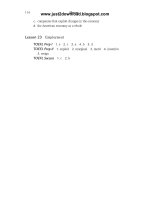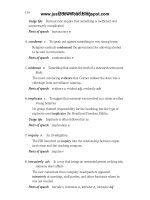Tài liệu Express Yourself writing skill for high school part 13 doc
Bạn đang xem bản rút gọn của tài liệu. Xem và tải ngay bản đầy đủ của tài liệu tại đây (98.97 KB, 8 trang )
CHAPTER
NARRATIVES FOR
ACADEMIC
P
URPOSES
USING STORIES to relate information and/or
recreate historical events are a rich literary tra-
dition. Whether you use the power of narration
to help you study or you use it to present your
own analysis of information, it is an important
writing tool.
HISTORICAL FICTION
Have you ever sat in a social studies class and dreaded the recitation of facts and details about people, places,
and events that had absolutely no connection to you or your life? Did you find it incredibly difficult to find
a way to remember who was who, and where and when all of the information came together? Unfortunately,
too few history books recreate history with a true sense of narrative purpose, which is, simply put, a good
story. Now this is not to say that there is no place for history books. The chronological recording of significant
events, which are accurate, is what history is all about. But sometimes adding a good story makes it all mem-
orable. In fact, the first definition for history in Webster’s New Collegiate Dictionary is tale or story.
85
EIGHT
NARRATIVES FOR ACADEMIC PURPOSES EXPRESS YOURSELF
However, the stories told in history, science, or sociology are obliged to be factually accurate. Non-fic-
tion, by definition, means true. But there is nothing like a good story to keep us interested and bolster our
memories. That is why historical fiction is such a popular literary genre. The term itself seems a contradic-
tion. If history is true then how can it be fiction? Well, historical fiction means that the events, places, dates,
even some of the characters are likely to be factually accurate, but that the stories are not necessarily true.
Consider the novel by Stephen Crane, The Red Badge of Courage. It takes place during the Civil War, and its
main character is a young boy who is fighting. The data about the war, details such as the types of weapons,
the number of wounded, the kinds of injuries, the lack of supplies, and the harsh camp conditions are all
factually accurate. But they become the conditions and experiences of a young man, like any teenager, who
must deal with them. The young man is a made-up hero and his character’s feelings and fears are the author’s
speculation. Does that make the story not historical? No. It makes it memorable.
Few students who have read The Red Badge of Courage forget that the Civil War took place in America
from 1861–1865—not because they memorized that information, but because they remember the main char-
acter—a boy fighting for his home. The details surrounding his extraordinary story became part of the story
itself.
Other notable books of historical fiction include:
Johnny Tremain by Esther Forbes: a young boy’s story of life and fighting in the American Revolution.
The Good Earth by Pearl S. Buck: a peasant family’s life and struggles in China in the early twentieth
century.
From Here to Eternity by James Jones: interwoven stories about soldiers and military life in World
War II.
Better Times than These by Winston Groome: interwoven stories about soldiers and military life dur-
ing the war in Vietnam.
City of Darkness, City of Light by Marge Piercy: interwoven stories about the women and men of the
French Revolution.
Tale of Two Cities by Charles Dickens: juxtaposed life in France and England during the French Revo-
lution.
Stones from the River by Ursula Hegi: the life and times of a German village during World War II.
Dream of the Walled City by Lisa Huang Fleischman: about China and a young girl’s friendship with
Mao Zedong.
The Dress Lodger by Sheri Holman: England during the cholera epidemic of 1831 provides an accu-
rate account of life in nineteenth-century England.
My Antonia by Willa Cather: a young girl lives on the prairie during the nineteenth century.
Giants in the Earth by O.E. Rolvaag: the story of Norwegian settlers in the northern United States
during the 19th century.
Girl With A Pearl Earring by Tracy Chevalier: the story of a housemaid in the home of the Dutch
painter Vermeer in the late 17th century.
EXPRESS YOURSELF NARRATIVES FOR ACADEMIC PURPOSES
86
When you are studying a period or a place in history, ask for a good story to help you connect to the
times and places. There are hundreds that your school librarian can suggest. The stories will help you under-
stand and remember because they will provide a rich human face to the fact and details of your study.
But how does all this relate to the writing that you can do? Well, one very important way to study his-
tory is to create your own stories around the information that you are expected to know. For example, just
as you study World War I, and have a hard time remembering just when it occurred and why it happened
and who some of the principal figures were, years from now students will study the attack on the World Trade
Center. They will be challenged to learn the details of that awful day, September 11, 2001, when New York
City and Washington, D.C. were attacked. Right now, we probably couldn’t find an American who couldn’t
relate every detail about the horrors that occurred. But twenty years from now, when this awful assault on
our country is part of our history and not part of our present experience, one way that students can learn it
all is to read or tell a detailed story. Consider how this brief fictional narrative integrates important factual
data while at the same time creates a very real human drama.
Tuesday, September 11, 2001 dawned a bright day. Gina Kovak prepared breakfast as usual
and watched her firefighter husband, David, help their two young daughters get their shoes and
socks on as they got ready for the school bus. The girls, ages five and seven, hugged their dad as
he waved them off to school, promising them a trip to Burger King when he came home that
evening.
Gina got David’s coffee mug ready to go, and at 8:05
A.M. he began his commute from their
Perth Amboy, New Jersey home to his firehouse in Manhattan’s business district. David kissed Gina
goodbye and she began her daily chores. At 8:55 she turned on the TV to keep her company as
she folded laundry and heard the first news of what everyone thought was an accident but quickly
learned was a terrorist attack on the World Trade Center.
Her immediate thoughts were shock and horror, but she didn’t really worry about David.
Then she watched a second plane slice into the second tower of the World Trade Center. Then she
heard and saw the explosion at the Pentagon. Then the plane in Pennsylvania crashed. Then she
began to worry about David.
The day was long and filled with worry. She couldn’t reach him, but she knew that his fire-
house would have been one of the first to reach the scene. She also knew that when the first tower
collapsed and then the second that David was certainly right in the heart of it. She carried a stone
in her heart all day, a sick feeling that nothing relieved. She watched the reports on television of
the terror unfolding at the Pentagon where they feared that hundreds had died. She learned that
passengers on the Pennsylvania flight had actually thwarted their hijackers and brought their plane
to the ground to save civilians on the ground. By the evening of September 11, 2001, Gina knew
that Dave would never come home.
He became one of almost 3,000 Americans destroyed by terrorists. He became one of many
fathers who would never see their babies in Halloween costumes that year or ever. She would have
to face Christmas morning alone with her little girls, and every Christmas morning from now on.
Who did this and why? Gina asked herself that question over and over. Terrorists who hate
the United States—that was the answer that the politicians gave. Osama bin Laden was named as
the mastermind, a man who hid in the faraway country of Afghanistan. They hate us because we
NARRATIVES FOR ACADEMIC PURPOSES EXPRESS YOURSELF
87
love freedom and peace, Gina thought. They hate us. Gina couldn’t understand how anyone could
hate Dave.
September 11, 2001 was the day that the United States of America declared war on terror-
ism and began a long period of military and diplomatic actions. September 11, 2001 was the day
that began the rest of Gina’s life without her best friend and husband.
Now, evaluate the narrative using the following rubric.
FOCUS CONTENT STYLE MECHANICS
EXCELLENT • insightful approach • accurate details • creative use of • error-free or
to the topic • well-developed character, theme, minimum errors that
• clear understanding • creatively integrated and tone do not interfere with
of the narrative task into text • excellent sentence communication
•5 w’s are • point of view is variety
established clear • excellent use of
vocabulary
• use of dialogue
VERY GOOD • topic is clear • accurate details • character, theme, • minimum errors
• understanding of used to develop the and tone are clear
the narrative task topic and point of • some sentence
is clear view variety and
• 5 w’s are vocabulary choice
established
GOOD • topic is clear • some accurate • character, theme, • errors that cause
• understanding of details not always and tone are confusion
the narrative task well-developed or uncertain
is faulty logically distributed • little sentence
•5 w’s weak variety
• simple but accurate
vocabulary
WEAK • topic is uncertain • inaccurate or vague • character, theme, • mechanics interfere
• poor or no under- use of details and tone are with communication
standing of the • poor development confused
narrative task not logically • poor sentence
• No sense of 5 w’s connected structure and poor
vocabulary use
EXPRESS YOURSELF
NARRATIVES FOR ACADEMIC PURPOSES
88
You may now consider transcribing your social studies notes into stories to help you remember details.
After you have written your story, go back to the rubric and see how well you did. Here are some sample activ-
ities to get you started:
1. Write an account of a day in the life of a Confederate soldier after the Battle of Antietam. Be sure to
include details about his food, uniform, and spirit. Include dates and important battle sites and names
of generals.
2. Write up your notes about President Truman’s dilemma to bomb Japan to end World War II as if
you were the President writing in his diary. Be sure to include two reasons why he was sure he was
right and two reasons why he thought he might be wrong. Include dates and names of famous peo-
ple who were part of Truman’s cabinet.
3. Become a spectator at President John F. Kennedy’s funeral procession and relate the sights, sounds,
and conversations you hear. Be sure to talk about the speculations surrounding his assassination and
include reference to the vice president who succeeded him.
4. Recreate a day in the life of a child working in a factory in Great Britain during the Industrial Rev-
olution. Be sure to include details of his entire day, from rising in the morning to going to bed at
night. Give dates as a reference, include the name of a specific city, and name a specific item of man-
ufacture.
5. Describe the farm life of a Chinese peasant. Include details of his housing, farming tools, crops, and
general working and living conditions. Include location and even the names of Chinese officials.
Even though you might not be assigned these writing topics, you should still consider making them
part of your independent study program. You could also ask your teacher for help in identifying what a good
narrative prompt would be. Often, students complain that they just don’t understand something and they
simply give up, when all the while they have the tools at their disposal to make new ideas meaningful to them.
Writing stories is one such learning tool. Try these:
➡ A day in the life of . . .
➡ A diary entry for an historical figure
➡ Recount an historical event from the perspective of a citizen
➡ Write a letter from one historical figure to another
You will find that if you write this way and force yourself to use the details of dates, times, places, names,
and numbers, you will look up important information and use it. This becomes reinforcement for your learn-
ing. Memorizing in isolation is never as effective as using information for a purpose. What better purpose
than telling a good story?
H
ISTORICAL NON-FICTION
The concept of learning about history through a fictionalized yet factual story is similar to learning about
history through a completely accurate story. Historical writing that uses only verified and accepted histori-
NARRATIVES FOR ACADEMIC PURPOSES EXPRESS YOURSELF
89
cal evidence can be as compelling as its fictional counterpart. Biographies and autobiographies are just two
examples. Like the non-fiction described above, these stories are rich human dramas told as good stories about
people, places, and events that actually happened. Consider the very popular autobiography Angela’s Ashes
by Frank McCourt. His story of his childhood in poverty-stricken Ireland has given his readers remarkable
insight into the anger and hostilities between Northern and Southern Ireland and between Ireland and
England.
Similarly, the very carefully researched biographies written by Carolly Erickson, such as Bloody Mary,
the life of Mary Tudor who ruled England in the mid-sixteenth century, give remarkably accurate pictures
of the life and times she writes about.
Whether you rely on non-fiction or fiction, good stories are the heart and soul of history. They will serve
you well to read and write them.
NARRATIVES FOR SCIENCE
Do you remember that wonderful science fiction book-turned-movie called Fantastic Voyage? More people
learned more about the circulatory system and the organs of the body from the movie than any science or
health class could ever hope to teach. In case you don’t know the film or the book, Fantastic Voyage was the
story of a miniaturized ship that took scientists through the bloodstream of a sedated patient. Sure it was
science fiction, but it presented accurate visuals and vocabulary about the body. You might want to rent the
film, it’s a classic.
Like the historical fiction we listed here, some science fiction that is based on accurately developed sci-
entific evidence include the medical thrillers of Michael Crichton and Robin Cook. Both men are scientists
and use their knowledge of practical and theoretical science to provide the background for some fascinating
stories. Ask your librarian for help locating their work. You’ll be surprised how exciting it will be to learn
science.
Apply the same rule of storytelling to help you learn science concepts. By writing out the information,
you help to identify what you don’t know so you can look it up and apply it. For example, create a story about
how the periodic table was developed. You can do a little research to help you gather information and then
write a brief paragraph about why the symbol for gold turned out to be Au. You’ll find that memorizing the
symbols will become easier because you will have a pattern for your learning.
Anything you study becomes easier when you write about it. Writing is thinking. By putting your think-
ing on paper you can identify what you don’t know or what you are confused about. You can then look up
information or re-read for clarification. If you attempt to write a narrative you always start with the 5 w’s, so
right off the bat you have to identify key information.
EXPRESS YOURSELF NARRATIVES FOR ACADEMIC PURPOSES
90
CHAPTER
NARRATIVES IN
EVERYDAY LIFE
EVERYDAY LIFE provides another set of stories
for each of us. As we become more dependent
on our computers to communicate with our fam-
ilies and friends, we become more and more
reliant on our ability to tell a good story. Whether
it’s a letter, a note, or a simple e-mail, if you
present a good story you’ve turned simple com-
munication into a welcome correspondence.
here’s nothing like opening a letter or e-mail from a friend or relative, especially if they live far away
and your communication is primarily electronic. Many people also find that it takes less time to use
the computer than it does to use the phone. You don’t have to plan time during a busy day because
you can compose your letter any time, day or night, without waking anybody up. Without the back and forth
of conversation you can say what you want and sign off for later. But that doesn’t mean that your corre-
91
NINE
NARRATIVES IN EVERYDAY LIFE EXPRESS YOURSELF
T
T
spondence should be devoid of careful planning and editing. One thing that the new generation of computer
correspondents has learned is that computer composing follows the same rules as pen and paper.
E-mail has changed the face of business communication. We can send the same message to dozens of peo-
ple with one keystroke. But there are rules that apply to e-mail in the workplace, and it is never too early to
learn them. Wherever you work you will find computers available, and you must be very cautious when using
them.
Ohio State University Professor Kitty O. Locker defines a person who follows the etiquette of computer
communication as a netizen or a citizen of the world of computers. It is a very important definition. Just as
citizens of a country must abide by the laws of its land, so must the citizen of cyberspace abide by its rules.
Some of those rules are unwritten and are only now being defined. For instance, criminal behavior in cyber-
space, like unleashing a virus on innocent and unsuspecting users, can be punished through the legal sys-
tem. But you are more concerned with the unwritten rules of etiquette. Here are just a few:
➡ Never use all capital or all lowercase letters.
➡ Always follow the conventions of standard written English.
➡ Don’t use code or abbreviation.
➡ Avoid forwarding chain letters and junk mail.
➡ Do not use profanity.
➡ Organize your message as if you were writing in longhand.
➡ Create subject lines that are clear, concise, and correct.
➡ If you use your business computer for personal correspondence, it is not private.
You may have noticed that there seems to be little difference between this list and a list that might be
written for regular writing. In fact, what separates e-mail in business from personal e-mail correspondence,
is the very specific nature of the business writing and the fact that it is not private. If you use your business
computer for personal use, many people, including your employer, will have the right and opportunity to
read it. Consequently, you should always use the computer at work with the same care that you would if you
were handing in a paper or mailing a letter with your signature on it.
That being said, what about your home computer? Nobody has access to it, so who cares about the rules
of etiquette? Not true. Just as you practice good manners at home to ensure that you’ll likely be well-man-
nered outside, practicing good writing all the time makes you more confident and skilled when you most
need it. Your friends deserve to see and read good writing, and you should take the opportunity to develop
your skills. You can’t practice enough!
Three important qualities of computer-generated writing apply to any writing that you do. They are
voice, tone, and style.
You may remember that back in Section 1, Chapter 3, we talked about attitude and tone. Well, another
way to describe attitude is voice. Your writing should always have your signature voice in it, and you never
want to convey a poor or negative attitude. But you may want to convey a mood or a tone. Perhaps you are
EXPRESS YOURSELF NARRATIVES IN EVERYDAY LIFE
92


